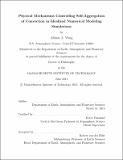Physical mechanisms controlling self-aggregation of convection in idealized numerical modeling simulations
Author(s)
Wing, Allison A
DownloadFull printable version (51.73Mb)
Other Contributors
Massachusetts Institute of Technology. Department of Earth, Atmospheric, and Planetary Sciences.
Advisor
Kerry Emanuel.
Terms of use
Metadata
Show full item recordAbstract
The ubiquity of cloud clusters and their role in modulating radiative cooling and the moisture distribution underlines the importance of understanding how and why tropical convection organizes. In this work, the fundamental mechanism underlying the self-aggregation of convection is explored using a cloud resolving model. The objective is to identify and quantify the interactions between the environment and the convection that allow the convection to spontaneously organize into a single cluster. Specifically, the System for Atmospheric Modeling is used to perform 3-d cloud system resolving simulations of radiative-convective equilibrium in a non-rotating framework, with interactive radiation and surface fluxes and fixed sea surface temperature. Self-aggregation only occurs at sea surface temperatures above a certain threshold. As the system evolves to an aggregated state, there are large changes to domain averaged quantities important to climate, such as radiative fluxes and moisture. Notably, self-aggregation begins as a dry patch that expands, eventually forcing all the convection into a single clump. Thus, when examining the initiation of self-aggregation, we focus on processes that can amplify this initial dry patch. Sensitivity tests suggest that wind-dependent surface fluxes and interactive longwave radiative fluxes are important for permitting self-aggregation. A novel method is introduced to quantify the magnitudes of the various feedbacks that control self-aggregation within the framework of the budget for the spatial variance of column - integrated frozen moist static energy. The absorption of shortwave radiation by atmospheric water vapor is found to be a key positive feedback in the evolution of aggregation. In addition, there is a positive wind speed - surface flux feedback whose role is to counteract a negative air-sea enthalpy disequilibrium - surface flux feedback. The longwave radiation - water vapor feedback transitions from positive to negative in the early and intermediate stages of aggregation. The long-wave radiation - cloud feedback is the dominant positive feedback that maintains the aggregated state once it develops. Importantly, the mechanisms that maintain the aggregated state are distinct from those that instigate the evolution of self-aggregation. These results and those of a companion study suggest that the temperature dependence of self-aggregation enters through the longwave feedback term.
Description
Thesis: Ph. D., Massachusetts Institute of Technology, Department of Earth, Atmospheric, and Planetary Sciences, 2014. This electronic version was submitted by the student author. The certified thesis is available in the Institute Archives and Special Collections. Cataloged from student-submitted PDF version of thesis. Includes bibliographical references (pages 141-146).
Date issued
2014Department
Massachusetts Institute of Technology. Department of Earth, Atmospheric, and Planetary SciencesPublisher
Massachusetts Institute of Technology
Keywords
Earth, Atmospheric, and Planetary Sciences.